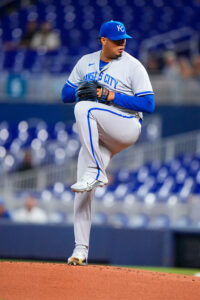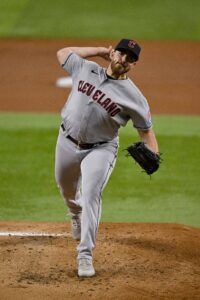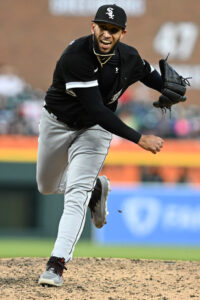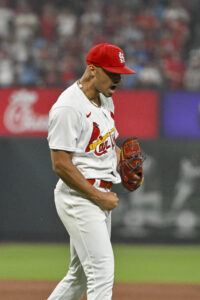As recently as a few months ago, the Rockies’ 2022 swap of Raimel Tapia for Blue Jays outfielder Randal Grichuk looked like a no-win trade for both parties. Tapia lasted one season in Toronto before being non-tendered and signing a minor league deal with the Red Sox. Grichuk’s offense didn’t tick up in his first year at Coors Field, as many had expected it to. He posted his typical sub-.300 OBP and surprisingly had his lowest power showing (by measure of ISO) since his rookie campaign. He was essentially a replacement-level player in 2022.
The 2023 season has brought about better results, however. Grichuk still isn’t hitting for the same level of power he did during his Toronto days (five homers, .172 ISO in 225 plate appearances), but he’s walking at a career-best 7.6% clip and currently has a 20.9% strikeout rate that ties his career-low mark.
Grichuk has undoubtedly had some good fortune on balls in play — his .368 BABIP is 70 points north of his career-high — but his .300/.364/.473 batting line is impressive all the same. The 31-year-old’s 90.6 mph average exit velocity and 45.2% hard-hit rate are both well above-average and only narrowly short of his career-best levels. His 24.2% line-drive rate is a personal best by a wide margin.
Things have gone particularly well for the veteran outfielder as of late. After a brief but dismal slump in the first couple weeks of June, Grichuk has bounced back with a .322/.375/.610 slash over his past 64 trips to the plate. Today’s front offices generally aren’t going to overreact to a short hot streak, but Grichuk’s recent uptick in production is particularly notable given that he’s slugged four of his five home runs in that stretch. After posting just a 33.6% fly-ball rate through mid-June, he’s had a 44% fly-ball rate during this heater.
While he’s having an undeniably productive season at the plate, Grichuk’s game has ostensibly taken a step back in other areas. Defensive Runs Saved (-8) and Outs Above Average (-6) agree that this is among the worst defensive seasons of his career — if not the worst.
As a rookie, Grichuk ranked in the 91st percentile of big leaguers in terms of average sprint speed, per Statcast. It’s only natural for a player to slow down as he ages, but Grichuk had well above-average speed as recently as 2021 (76th percentile) and 2022 (68th percentile). He’s down to the 46th percentile of MLB players in 2023 — the first below-average season of his career. His arm strength remains above average, but Statcast now places him in just the fourth percentile of MLB outfielders in terms of his outfield jumps.
Taken in totality, it’s a somewhat limited skill set. Grichuk can play all three outfield spots but has generally rated best in right field. He’s hitting well against righties in 2023 (.295/.357/.439) and tattooing lefties (.313/.380/.537), but his career body of work is below-average when he’s not holding the platoon advantage.
Grichuk is a solid enough role player who’s been thrust into an everyday role with the Rockies. The results in ’23 have been decent enough, but combined with his 2022 season he still looks better deployed in a more limited capacity.
That’s likely how many contenders will view him. Grichuk is a career .264/.311/.498 hitter against southpaws who’s made gains in terms of his overall plate discipline this season, albeit at the expense of some power. His defensive ratings are down, but that’s partially due to being played in center field, where he’s no longer a good fit, and in left field, where he hadn’t logged an innings since 2018 (when he played six frames there).
A contending team could install Grichuk as a part-time DH and right fielder whose primary role is to step into the lineup and help against southpaws. He can cover center field in a pinch and has enough bat that he’s not a total liability when needed to play against righties.
There are plenty of clubs in need of just this type of skill set. The Giants, Guardians, Twins and Brewers are all playoff hopefuls whose team-wide production against left-handed pitching ranks in the bottom seven of MLB clubs (by measure of wRC+). The D-backs, who have an all-left-handed outfield, are only slightly better, at 21st.
In seasons past, it might’ve been fair to wonder whether the Rockies would move Grichuk at all. Frankly, based on their history of hanging onto impending free agents, it still is. However, Rockies manager Bud Black said on MLB Network Radio on SiriusXM just today that he believes his team’s front office will be “more active” than in seasons past at this year’s trade deadline.
Grichuk is a natural candidate to be moved. He’s a free agent at season’s end who’s earning $9.333MM this season. The Blue Jays are on the hook for $4.333MM of that sum as part of the trade that brought him to Denver in the first place, however, meaning an acquiring team would only be responsible for $2.02MM of the $5MM the Rockies are paying him (as of tomorrow). Colorado, of course, could pay down some of that money to increase his appeal.
Grichuk isn’t going to be a contender’s marquee addition, but he can can deepen a team’s bench and — based on Black’s comments today — seems like a player with a good chance to change teams in the next 14 days.




